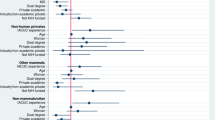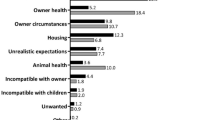Abstract
Institutional Animal Care and Use Committees (IACUCs) are federally mandated to ensure the welfare of animals used in research, testing and teaching. An IACUC must oversee institutional animal care and use programs and promote compliance with all regulations and policies. Postapproval monitoring (PAM) is one administrative tool that an IACUC can implement to help fulfill its federal and societal responsibility. Here, the authors describe the PAM program at a large academic institution, considering the program's accomplishments and how the program has changed since its inception. The authors also provide a retrospective analysis of compliance records during the first 10 y of the program, which demonstrate improved compliance following initiation of PAM.
This is a preview of subscription content, access via your institution
Access options
Subscribe to this journal
We are sorry, but there is no personal subscription option available for your country.
Buy this article
- Purchase on Springer Link
- Instant access to full article PDF
Prices may be subject to local taxes which are calculated during checkout



Similar content being viewed by others
References
Bayne, K.A.L. & Turner, P.V. Laboratory Animal Welfare (Academic, London, 2014).
Institute for Laboratory Animal Research. Guide for the Care and Use of Laboratory Animals 8th edn. (National Academies Press, Washington, DC, 2011).
Interagency Research Animal Committee. U.S. Government Principles for the Utilization and Care of Vertebrate Animals Used in Testing, Research and Training (Office of Science and Technology Policy, Washington, DC, 1985).
Russell, W.M.S. & Burch, R.L. The Principles of Humane Experimental Technique (Methuen, London, 1959).
Public Health Service. Policy on Humane Care and Use of Laboratory Animals (US Department of Health and Human Services, Washington, DC, 1986; amended, 2002).
Animal Welfare Act Regulations 9 CFR. Chapter 1, Subchapter A, Part 2.
Banks, R.E. & Norton, J.N. A sample postapproval monitoring program in academia. ILAR J. 49, 402–418 (2008).
Lowman, R.P. The institutional official and postapproval monitoring: the view from 10,000 feet. ILAR J. 49, 379–387 (2008).
Klein, H.J. & Bayne, K.A. Establishing a culture of care, conscience, and responsibility: addressing the improvement of scientific discovery and animal welfare through science-based performance standards. ILAR J. 48, 3–11 (2007).
Dale, W.E. Postapproval monitoring and the role of the compliance office. ILAR J. 49, 393–401 (2008).
Institute of Laboratory Animal Research. Guide for the Care and Use of Laboratory Animals 7th edn. (National Academies Press, Washington, DC, 1996).
Duke University Animal Care & Use Program. Policy on Cage Space Requirements for Mice (Duke University, Durham, NC, 2014). http://vetmed.duhs.duke.edu/PDF/Policies/Animal%20Use%20Policies/policy_on_cage_density_requirements.pdf.
National Institutes of Health. Office of Laboratory Animal Welfare: Reporting Noncompliance (National Institutes of Health, Bethesda, MD, 2015). http://grants.nih.gov/grants/olaw/reporting_noncompliance.htm.
Collins, J.G. Postapproval monitoring and the Institutional Animal Care and Use Committee (IACUC). ILAR J. 49, 388–392 (2008).
Stokes, W.S. Humane endpoints for laboratory animals used in regulatory testing. ILAR J. 43, S31–S38 (2002).
Ullman-Culleré, M.H. & Foltz, C.J. Body condition scoring: a rapid and accurate method for assessing health status in mice. Lab. Anim. Sci. 49, 319–323 (1999).
Warn, P.A. et al. Infrared body temperature measurement of mice as an early predictor of death in experimental fungal infections. Lab. Anim. 37, 126–131 (2003).
Acknowledgements
We thank the Statistical Consulting Center of the Duke University Department of Statistical Science, and particularly Dr. Edwin Iversen, for excellent guidance on statistical analysis of our data. We thank Mr. Michael Gentile and Drs. Laura Hale and Anna Hampton for assistance in editing the manuscript.
Author information
Authors and Affiliations
Corresponding author
Ethics declarations
Competing interests
The authors declare no competing financial interests.
Rights and permissions
About this article
Cite this article
Vanderford, D., Doss, S. & Banks, R. A retrospective review of postapproval monitoring at a large academic institution. Lab Anim 44, 395–401 (2015). https://doi.org/10.1038/laban.856
Received:
Accepted:
Published:
Issue Date:
DOI: https://doi.org/10.1038/laban.856



